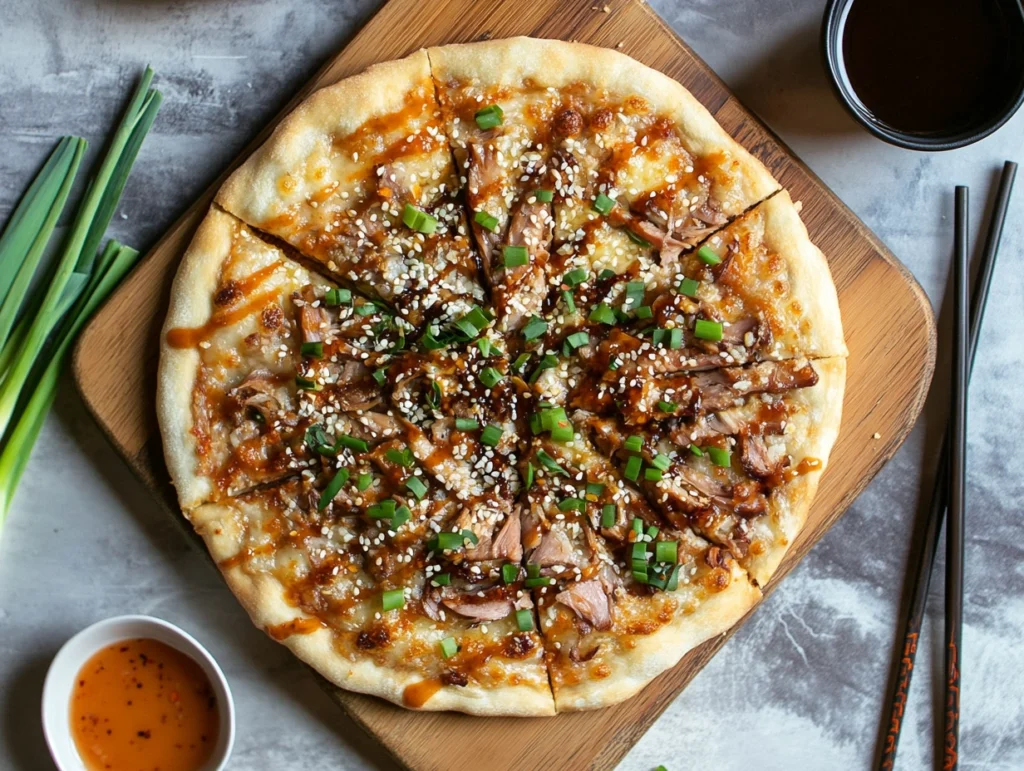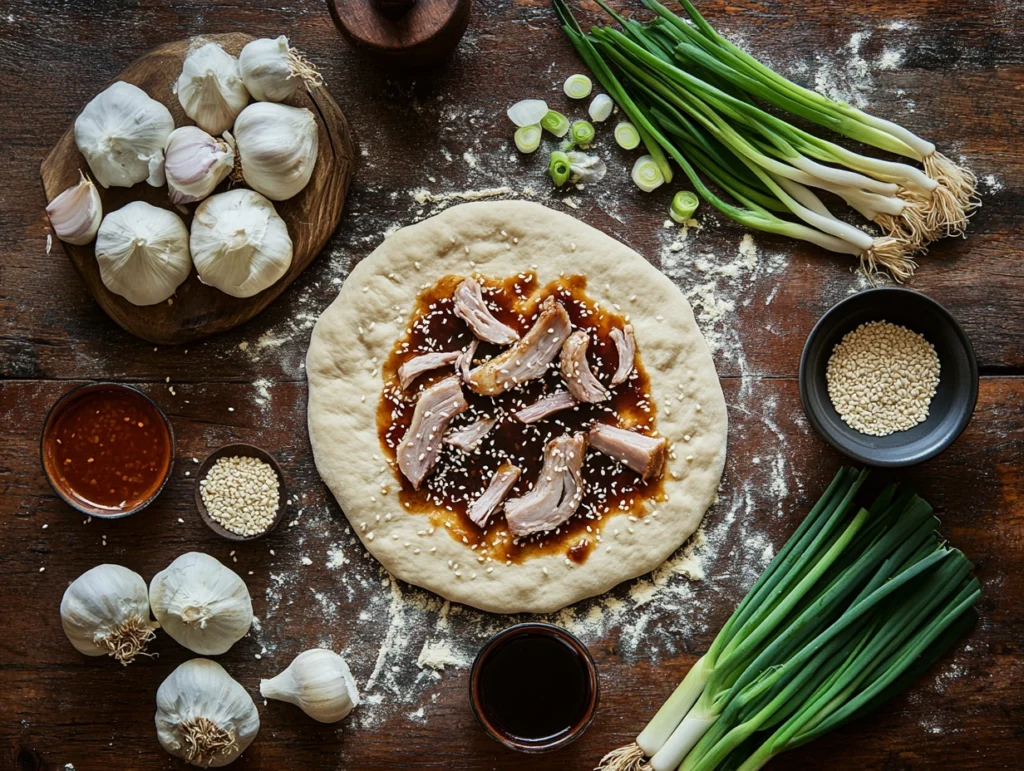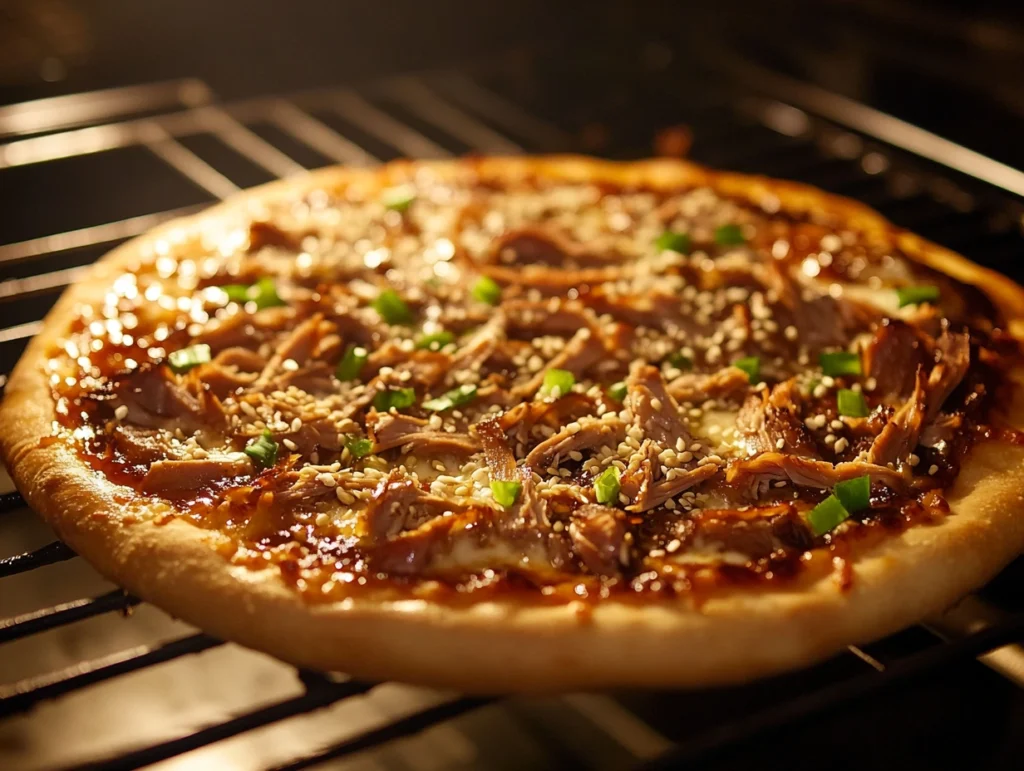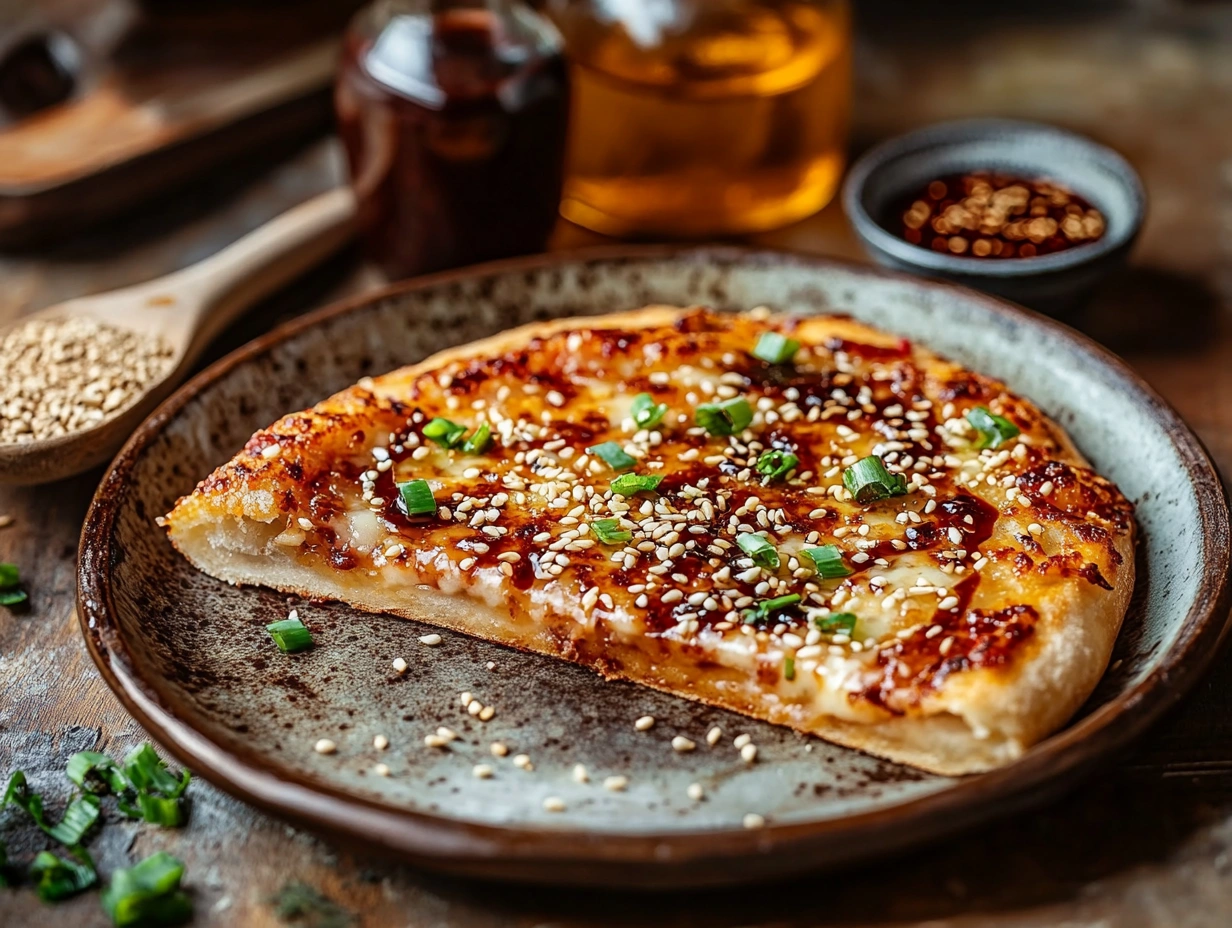Introduction
When we think of pizza, Italian flavors and traditions often come to mind. However, the concept of pizza has traveled across borders, inspiring unique adaptations. Chinese pizza is one such culinary marvel, blending traditional Chinese ingredients and techniques with the essence of a classic pizza.
This article delves into the world of Chinese pizza, exploring its history, unique features, and recipes. Whether you’re curious about its origins or eager to make it at home, this guide has something for everyone.
Historical Background
Origins of Pizza in China
Pizza’s journey to China began in the 1980s with the arrival of international fast-food chains like Pizza Hut. Initially viewed as a novelty, pizza gradually gained popularity, especially among younger generations.
Chinese chefs and restaurateurs soon began experimenting, combining traditional Chinese ingredients with pizza’s Western appeal. The result was a fusion that catered to local palates, giving birth to Chinese-style pizza.
Evolution of Chinese-Style Pizza
Unlike its Western counterpart, Chinese pizza often features thin crusts, bold flavors, and unconventional toppings. From Peking duck to hotpot-inspired varieties, these innovations reflect China’s rich culinary diversity and willingness to adapt global trends.
Here’s the continuation of the article:
What is Chinese Style Pizza?
Unique Characteristics
Chinese-style pizza stands out for its creative approach to flavors and presentation. It often uses thinner crusts, influenced by Chinese flatbreads, and incorporates a mix of sweet, savory, and spicy toppings. Common ingredients like hoisin sauce, sesame seeds, and green onions bring a distinctly Chinese twist to this beloved dish.
Unlike traditional pizza, Chinese-style pizza may also use alternative bases such as pancakes or scallion flatbreads, offering a diverse range of textures and tastes.
Common Ingredients and Toppings
Popular toppings for Chinese-style pizza include:
- Peking Duck: Thin slices of roasted duck with crispy skin, paired with hoisin sauce and cucumbers.
- Char Siu (BBQ Pork): Sweet and savory pork slices that complement cheesy or tomato-based sauces.
- Hotpot Flavors: Ingredients like mala sauce, tofu, and Sichuan peppercorns for a bold, spicy twist.
- Vegetables: Bok choy, mushrooms, bell peppers, and bamboo shoots add fresh and vibrant flavors.
These toppings redefine pizza, blending traditional Chinese flavors with Western techniques.
Cooking Techniques
Chinese-style pizza is often cooked in unique ways to enhance its flavor. Some variations are prepared in traditional pizza ovens, while others are pan-fried or baked in home ovens. For thin and crispy textures, chefs may pre-bake the crust before adding toppings.
What is Chinese Pizza Called?
Terminology in Mandarin and Regional Dialects
In Mandarin, the word for pizza is 披萨 (pī sà), borrowed phonetically from English. However, when referring to Chinese-style pizza specifically, terms like 中式披萨 (zhōng shì pī sà) or 中国风披萨 (zhōng guó fēng pī sà), meaning “Chinese-style pizza” or “China-inspired pizza,” are commonly used.
Popular Names and Variations
In different regions of China, you might encounter unique names and interpretations of Chinese pizza, such as:
- Cong You Bing Pizza: A fusion of scallion pancakes with traditional pizza toppings.
- Bing-Style Pizza: Flatbreads topped with savory ingredients, resembling pizza but with a distinct Chinese twist.
These names highlight the regional creativity in adapting pizza to local tastes.
What Kind of Pizza is in China?
Western Influence and Adaptation
In China, pizza often reflects a fusion of Western techniques and Chinese culinary preferences. Western-style pizzas, popularized by chains like Pizza Hut and Domino’s, are commonly available, but they have been adapted to suit local tastes. For instance, you’ll find pizzas topped with ingredients like seafood, corn, and even sweet fruits such as pineapple and durian.

Alt Text: A fully baked Chinese-style pizza topped with Peking duck and scallions.
Fusion Pizzas with Chinese Flavors
Fusion pizzas in China are where creativity truly shines. These pizzas incorporate iconic Chinese ingredients and dishes, creating a unique dining experience. Examples include:
- Peking Duck Pizza: Featuring hoisin sauce, roasted duck, and scallions, this pizza combines a famous Chinese dish with pizza’s familiar format.
- Hotpot Pizza: Inspired by Sichuan hotpot, this pizza includes mala sauce, tofu, and chili oil for a spicy kick.
- Dim Sum Pizza: Topped with shrimp dumplings, BBQ pork buns, and soy sauce drizzle, it brings the flavors of dim sum to pizza.
These inventive combinations showcase the adaptability of pizza in Chinese cuisine.
Regional Variations Across China
Pizza in China varies significantly by region. For example:
- Northern China: Hearty pizzas with lamb or beef, reflecting the meat-heavy diet of the region.
- Southern China: Lighter pizzas with fresh seafood, fruits, and tropical flavors.
- Western China: Incorporating bold spices like cumin and chili, often influenced by Uyghur cuisine.
Each region’s unique culinary identity is reflected in its approach to pizza.
The Name of Japanese Pizza
Introduction to Okonomiyaki
Though not a traditional pizza, Okonomiyaki is often referred to as “Japanese pizza” due to its round shape and customizable toppings. It is a savory pancake made with flour, eggs, shredded cabbage, and various other ingredients like seafood, pork, or cheese.
Differences Between Okonomiyaki and Traditional Pizza
Okonomiyaki differs from pizza in several key ways:
- Base: Instead of a dough crust, it uses a batter made with flour and cabbage.
- Toppings: While pizza often features cheese and tomato sauce, Okonomiyaki is topped with mayonnaise, bonito flakes, and a special savory sauce.
- Cooking Method: Okonomiyaki is typically cooked on a griddle, giving it a crispy exterior and soft interior.
Despite these differences, its versatility and communal cooking style make it a close cousin to pizza.
Cultural Significance in Japan
Okonomiyaki is a beloved comfort food in Japan, often enjoyed in specialized restaurants or at home with family. Its name translates to “grill what you like,” reflecting its highly customizable nature, similar to the spirit of pizza.
Major Pizza Chains in China
Presence of International Brands
International pizza chains like Pizza Hut, Domino’s, and Papa John’s have a strong presence in China, catering to a growing demand for Western-style fast food. These chains have adapted their menus to include local flavors while maintaining their global appeal.
- Pizza Hut: Known for its upscale dining experience in China, Pizza Hut offers unique menu items such as durian pizza and Peking duck pizza.
- Domino’s: Focuses on delivery services and introduces toppings like sweet corn, shrimp, and BBQ pork to appeal to local tastes.
- Papa John’s: Offers a mix of traditional Western-style pizzas and fusion options with ingredients like Beijing roast duck.
These adaptations highlight the importance of localization in the Chinese market.
Localization Strategies and Menu Adaptations
To cater to Chinese consumers, pizza chains often:
- Use sauces like hoisin, mala, or sweet chili instead of traditional tomato sauce.
- Offer side dishes like spring rolls, dumplings, or noodle soups to complement pizza.
- Experiment with crusts, such as adding sesame seeds or cheese-stuffed edges.
This fusion of global and local influences has helped pizza chains thrive in China’s competitive food industry.
Market Share and Consumer Preferences
The pizza market in China is expanding rapidly, driven by younger consumers and urbanization. Local pizza brands are also gaining popularity by offering affordable options with Chinese flavors, creating a competitive environment for international chains.
Traditional Chinese Dishes Similar to Pizza
Cong You Bing (Scallion Pancakes)
Cong You Bing is a savory Chinese flatbread made with flour, scallions, and oil. Its crispy texture and layered structure resemble thin-crust pizza, making it a popular base for fusion pizzas in China.
- How It’s Made: The dough is rolled with scallions, folded multiple times, and pan-fried until golden brown.
- Common Variations: Topped with sesame seeds or served with dipping sauces like soy or chili oil.
Jianbing (Savory Crepes)
Jianbing is a traditional Chinese street food often referred to as “Chinese crepes.” It’s made with a batter of wheat and mung bean flour, spread thinly on a griddle, and filled with ingredients like eggs, scallions, and crispy wonton.
- Why It’s Similar to Pizza: Its customizable fillings and foldable structure make it comparable to a personal pizza.
- Fusion Potential: Jianbing pizzas are emerging as trendy snacks, featuring cheese and tomato sauce fillings.
Bing (Chinese Flatbreads)
Bing refers to a variety of Chinese flatbreads that serve as the foundation for many dishes. These flatbreads are versatile and often used to create Chinese-style pizzas.
- Varieties: Includes sesame-studded Shaobing or stuffed Bing filled with meat or vegetables.
- Pizza Inspiration: Topped with ingredients like char siu or roasted vegetables, Bing serves as a hearty alternative to traditional pizza crusts.
Recipes for Chinese-Style Pizza
Homemade Chinese Pizza Dough

Alt Text: Ingredients for making Chinese pizza, such as hoisin sauce, scallions, and sliced duck.
To create a Chinese-style pizza at home, start with a simple dough recipe that balances a soft yet crisp texture:
Ingredients:
- 2 1/2 cups of all-purpose flour
- 1 teaspoon of sugar
- 1 teaspoon of salt
- 2 1/4 teaspoons of instant yeast
- 3/4 cup of warm water
- 2 tablespoons of sesame oil
Instructions:
- In a mixing bowl, combine flour, sugar, salt, and yeast.
- Gradually add warm water and sesame oil, mixing until the dough forms.
- Knead the dough for 8-10 minutes until it becomes smooth and elastic.
- Cover the dough with a towel and let it rise for 1 hour.
- Roll out the dough to your desired thickness, and it’s ready for toppings.
Suggested Toppings and Sauces
Here are some popular combinations for Chinese-style pizza:
- Peking Duck Pizza:
- Base: Hoisin sauce.
- Toppings: Shredded duck, scallions, and cucumber slices.
- Hotpot Pizza:
- Base: Spicy mala sauce.
- Toppings: Tofu, thinly sliced beef, chili oil, and sesame seeds.
- Char Siu Delight:
- Base: Sweet BBQ sauce.
- Toppings: Slices of char siu, bell peppers, and pineapple chunks.
- Vegetarian Fusion:
- Base: Garlic and sesame oil.
- Toppings: Bok choy, mushrooms, and bamboo shoots.
These toppings showcase the versatility of Chinese-style pizza, blending bold flavors and fresh ingredients.
Step-by-Step Cooking Instructions
- Preheat the Oven: Set the oven to 450°F (232°C) and place a pizza stone inside.
- Prepare the Crust: Roll out the dough and transfer it to a parchment-lined pizza peel or baking sheet.
- Add the Base Sauce: Spread hoisin, mala, or BBQ sauce evenly over the dough.
- Top Your Pizza: Layer your chosen toppings, ensuring even distribution for balanced flavor.
- Bake: Transfer the pizza to the preheated stone and bake for 12-15 minutes, or until the crust is golden and the toppings are cooked.
- Garnish and Serve: Finish with sesame seeds, fresh herbs, or a drizzle of chili oil before serving.

Alt Text: Chinese-style pizza baking in the oven with hoisin sauce, duck, and scallions.
Nutritional Analysis
Calorie Content
The calorie content of Chinese-style pizza varies depending on the crust, sauce, and toppings used. For instance:
- Peking Duck Pizza: A single slice may contain around 250-300 calories, with higher protein and fat content from the duck.
- Vegetarian Fusion Pizza: A lighter option, with approximately 180-220 calories per slice due to its vegetable-based toppings.
Macronutrient Breakdown
Here’s a general breakdown for an average slice of Chinese-style pizza:
- Carbohydrates: 20-30g (depending on the crust).
- Protein: 8-15g (varies with toppings like duck or tofu).
- Fat: 6-12g (influenced by sesame oil and meats).
Health Considerations
Chinese-style pizza can be a balanced meal when crafted thoughtfully. To keep it healthy:
- Use whole-grain or low-carb crusts.
- Opt for lean protein toppings like tofu or chicken.
- Limit high-fat sauces and opt for lighter alternatives like garlic sesame oil.
Cultural Perception and Acceptance
Reception Among Chinese Consumers
Chinese-style pizza has gained popularity among younger generations and urban populations in China. While traditional Western pizza is still viewed as a novelty, the fusion approach resonates more deeply with local tastes. The inclusion of familiar ingredients like Peking duck and mala sauce bridges the gap between foreign cuisine and Chinese culinary traditions.
Pizza is often seen as a social food in China, enjoyed during gatherings, celebrations, or casual meals. Its adaptability to different flavor profiles has helped it find a niche in the ever-evolving Chinese food culture.
Influence on Chinese Cuisine
The rise of pizza in China has inspired chefs to experiment beyond traditional boundaries, leading to a surge in fusion dishes. For example, scallion pancakes topped with cheese and meat are now common in fusion restaurants. This cross-cultural exchange continues to enrich Chinese cuisine, blending international trends with regional flavors.
Global Perception of Chinese-Style Pizza
Internationally, Chinese-style pizza is celebrated for its creativity and bold flavors. Food enthusiasts and chefs worldwide have embraced it as an example of how pizza can transcend cultural boundaries. It has become a symbol of culinary fusion, showcasing the potential for innovation in global cuisine.
Future Trends
Innovations in Chinese Pizza
As the demand for Chinese-style pizza grows, innovations are on the rise. Some emerging trends include:
- Plant-Based Ingredients: Incorporating vegan meats and cheeses to appeal to health-conscious consumers.
- Dessert Pizzas: Using bases like sweet rice cakes topped with fruits, red bean paste, or matcha drizzle.
- Tech-Enhanced Customization: Using apps and AI-driven systems to allow consumers to customize pizzas with real-time visuals.
Potential for International Popularity
With the global rise of fusion cuisines, Chinese-style pizza has the potential to become a worldwide phenomenon. Its unique flavors and adaptability make it a strong contender for inclusion in diverse culinary markets, particularly in urban and foodie-centric regions.
Fusion Cuisine and Culinary Experimentation
The trend of blending traditional dishes with global influences is likely to continue, leading to more creative takes on pizza. Future innovations may include:
- Hybrid dishes combining Chinese and other Asian cuisines, like sushi-inspired pizza.
- Incorporating new cooking techniques such as air frying or sous-vide for enhanced textures.
This ongoing experimentation ensures that Chinese-style pizza will remain dynamic and exciting.
Conclusion
Chinese-style pizza represents the perfect harmony of tradition and innovation. By blending iconic Chinese flavors with the universal appeal of pizza, it has created a unique culinary experience that delights palates worldwide.
From its origins in fusion dishes to its modern interpretations, Chinese-style pizza highlights the creative potential of cross-cultural cuisine. Whether you’re savoring a slice of Peking duck pizza, experimenting with homemade recipes, or exploring fusion dishes in China, this delicious innovation continues to redefine what pizza can be.
So, why not try your hand at crafting a Chinese-style pizza or seek it out at a local pizzeria? It’s an experience that combines the best of both worlds—traditional Chinese flavors and the comfort of pizza.
FAQs
Is Chinese Pizza Authentic Chinese Cuisine?
While Chinese-style pizza may not be a traditional Chinese dish, it has become an authentic representation of fusion cuisine. By incorporating local ingredients and flavors, it aligns with the Chinese culinary tradition of adaptability and creativity.
Where Can I Try Chinese-Style Pizza?
You can find Chinese-style pizza in specialized fusion restaurants, upscale pizzerias in China, and some international establishments that focus on creative culinary offerings. Alternatively, try making it at home using the recipes provided!
How Does Chinese Pizza Differ from Western Pizza?
Chinese-style pizza uses unique ingredients like hoisin sauce, mala seasoning, and Peking duck, offering bold and diverse flavors. It often has a thinner crust and incorporates cooking techniques inspired by traditional Chinese flatbreads.
Can I Make Chinese Pizza at Home?
Absolutely! With a few simple ingredients and the recipes shared in this guide, you can create your own Chinese-style pizza at home. Experiment with sauces, toppings, and crusts to find your perfect combination.

